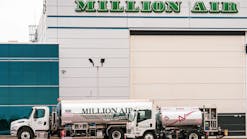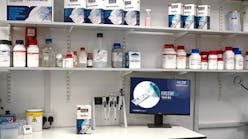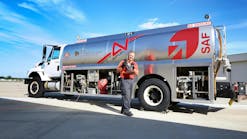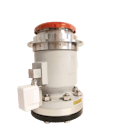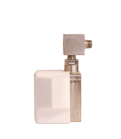Today, most fuel uplifted into commercial aircraft flows through a filtration system known as a Full Flow Monitor, which is designed to remove both water and solids. The water is removed through absorption by what the industry refers to as Super Absorbent Polymer (SAP). More specifically, sodium polyacrylate.
“When sodium polyacrylate (or SAP), which is the same stuff that goes into diapers, reaches its saturation point with water, it literally stops the flow of fuel,” states John Leonard, refined fuels market manager for Facet Filtration. “It’s designed to prevent any water from getting into the fuel being put in the aircraft.”
However, under a variety of conditions, these “Pampers for the fueling industry,” as Leonard calls them, can leak small quantities of crystal-like gel, which can move into the aircraft during fueling. There have been eight documented events where this has happened and caused operability issues for the aircraft.
The most serious of these incidents occurred in April 2010 in Surabaya, where both engines on an Airbus A330 lost thrust control after becoming gummed up with SAP. There were 309 passengers and a crew of 13 on board the Cathay Pacific flight. The crew successfully landed the plane at almost twice the normal landing speed. Fifty-seven passengers were injured in this event.
Since then, there have been seven similar incidents involving engine issues allegedly linked to fuel contamination from filter monitors.
The International Air Transport Association (IATA) convened a Special Interest Group in May 2014 to investigate these incidents and determine if there was a correlation between fuel control unit and/or hydro-mechanical unit operability issues and the presence of SAP. Participants in this group included representatives from airframe and engine OEMs, aviation fuel filter manufacturers, airlines, airline associations and the Energy Institute (EI). The group determined there was no guarantee that SAP will not pass downstream of the filter monitor elements when in service.
Tom Muzik, business unit manager of Parker Velcon, sat on this committee. He states their investigation found “SAP filters do shed SAP in some amount—some more than others. But they do shed SAP, and they shed more SAP as differential pressure increases,” he says. “Therein lies the rub, we know that SAP at some level causes an issue, but it would take billions of dollars and years of research to figure out how much is too much.”
In an industry where safety is paramount, an unknown like this is unacceptable. As such, engine manufacturers have reduced their allowable SAP tolerance from 50 parts per billion to zero. And, the Special Interest Group decided, “We have to come up with an alternative solution that does not involve this particular polymer because of its propensity—under certain conditions—to go downstream,” Leonard says.
Differential Pressure Difference
The IATA group first recommended standardizing the differential pressure requirement for fueling. When a filter monitor becomes saturated and stops or slows the flow of fuel, there is a spike in differential pressure. This pressure is monitored by differential pressure gauges, such as those from Gammon Technical Products.
Differential pressure monitors were in place in the Surabaya incident, but an industry expert, who wishes to remain anonymous, reports “no one looked at them, believing there was a problem with the hardware – not the fuel. But what had happened is the operator had gotten a lot of water into the fueling system. The filters stopped it, but they kept struggling to get flow. This eventually damaged the filters and pushed water and filter media into the aircraft.”
In the U.S., aviation differential pressure cannot exceed 15 psi. However, in other countries up to 22 psi of differential pressure has been allowed in plane fueling.
“But, the IATA study found if differential pressure exceeds 15 psi, the possibility of the extrusion of this polymer goes up dramatically,” Leonard says.
IATA now requires operators to change the filter media at 15 psi and install an automatic switch that stops fueling when differential pressure becomes too high.
Airlines for America (A4A) reports that “A4A and its members have already taken proven steps to reduce the risk of SAP migration from filter monitors, and this includes lowering the fuel monitor differential pressure limit. We are also working together with our partners across the industry to evaluate alternative filtration solutions that do not utilize SAP.”
Proposed Solutions
Further study by the Special Interest Group revealed that addressing differential pressure was not enough. In fact, they found trace amounts of filter media can be released at any differential pressure. For this reason, the Special Interest Group decided to outlaw the use of SAP by December 2020; putting the date out into the future to give the industry time to develop alternatives.
Whether those options make it through an industry-mandated three-part certification process in time to meet the mandate, all equipment is retrofitted in time, and the industry can bear the financial costs of this change, are questions that remain.
Marcus Wildschütz, president of FAUDI Aviation GmbH, states he feels some unease as the industry marches toward the 2020 deadline.
“I’m surprised the whole industry is not in turmoil right now,” he says. “People are taking a wait-and-see approach, and my biggest fear for the entire industry is they will rush into a decision without any in-depth knowledge.”
“Today filter companies are scrambling to come up with alternatives to fueling an aircraft that do not involve full flow monitors,” Leonard adds. “There are three options on the table right now.”
The proposed options are:
Filter/Water separators (also known as filter coalescers). Taking everything back to filter/water separators, which were effectively used before SAP filters became the norm.
Leonard says the positive is that this is “absolute proven technology. There’s no doubt that it works.” A water separator, however, is larger and heavier than its SAP counterparts, and complicating the change is existing equipment. “Existing fueling equipment is built to handle a full-flow monitor. Is it physically possible to swap in a water separator? In most instances, it is not,” Leonard says.
Though manufacturers are trying to make these units smaller and lighter in weight, Muzik states though “we can make them smaller and we can make them more compact, it will likely never get to the point where they’re the same size as a filter monitor. The reason monitors were created is because they were small, lightweight and compact.”
Water barrier approach. Currently in development with Parker Velcon, this system takes a 2-inch by 30-inch element and puts a wrap around the outside that repels water. “We’re taking a hydrophobic material that rejects dirt and water,” says Muzik. “It’s a very porous material that is small enough to block the water that’s in fuel, while letting the fuel through.”
Leonard maintains he’s seen qualification numbers and believes the system has good potential. The water the system collects will drop to the bottom of the housing, where an operator will need to drain the water off through a hole in the bottom of the housing at the end of each day. This is what is done currently with filter water separators.
“However,” Leonard says, “a filter water separator has a sump to collect water and a sensor to alert the operator. The typical monitor vessel does not have a sump or a sensor. As a result, there’s the possibility of collecting water in a vessel that’s not designed to do it. Operator vigilance will be a necessity.”
A Dirt Defense filter with a water sensor. FAUDI’s Dirt Defense filter (a micronic filter) plugs in where the existing 2-inch monitors go, and it stops dirt from going downstream into the aircraft. The Dirt Defense requires a water sensor upstream of the filter vessel. Both FAUDI and Facet have successfully passed EI’s Dirt Defense testing protocol (1599).
“The Dirt Defense is available as a drop-in solution. We have raw materials in stock for 10,000 elements. It is easy to manufacture and deliver,” Wildschütz states. “This solution is ready.”
This solution will work, states Muzik because “most plane fueling applications have very low water. I say most because if you do have water, then what do you do? Shut down the entire fueling system, and then what do you do? You need to bring in another piece of equipment. You must bring a filter water separator over; this is a solution that has some hair involved in it. It also could have a very high dollar cost. There are some hydrant systems that are notoriously wet. In a very dry system, it will be a viable solution but unfortunately that’s not always the case.”
Putting Solutions to the Test
A4A reports that “Aviation fuel manufacturers are proposing a number of alternative filtration or sensor technologies that may replace filter monitors. In keeping focus on safety, our members are thoroughly evaluating any proposed solutions before they can be implemented.”
This fact prompts Leonard to state that “though Dec. 31, 2020, seems a long way off, it’s not.”
There is a global industry effort involving A4A, IATA, the Joint Inspection Group, filter manufacturers and the EI to fully vet new sensor technologies.
“The goal of this work is to identify safe and effective solutions that provide the same or better protection from dirt and water,” A4A officials say.
Solutions must first pass EI testing protocols before they can be used. First, the system needs to go through a real test on a real rig, then it must go through what’s called a robustness protocol, which puts the elements under severe stress, to see how it reacts in operation. Finally, there are field trials.
“Only after a new technology has passed all of these challenges is it fit for service,” Leonard says. “From the time you start your EI testing to the time you’ve passed field trials will probably take at least 12 months.”
Currently, only the Dirt Defense has obtained EI certification. However, this solution still must go through industry testing.
“A4A and JIG, which are the two governing bodies, have not accepted this solution as a valuable implemented device,” Muzik says.
However, Wildschütz states this process should go smoothly, noting that the Dirt Defense uses “microfiltration technologies, which have been used in the industry for decades. Other technology will need to be proven for a much longer time [in testing].
“All of these new technologies, because they are new, are going to use a free water sensor qualified to EI-1598, just to make sure the systems are absolutely safe,” he continues. “That’s not only for the field trial but also in actual use. You may be in a situation later with different environmental issues, and you want to be sure your system is really safe, because you want to be sure you are delivering safe fuel to the aircraft.”
Companies like Boeing, GE and Rolls-Royce are calling the shots, however. These giants in the aircraft world have said they will no longer allow SAPs after the deadline. If an airline continues to use them and an incident occurs, the airline will be held liable.
“If they [engine manufacturers] won’t accept SAP, then the airlines cannot accept it, and it gets pushed down to everyone in the industry to correct the problem,” says Dan Murray, president of Total Control Systems. “I’d love to tell you that the industry is ready for this, but I think the reality is that Total Control Systems is ready. Our electronic automation and control can measure differential pressure and water in the fuel. We can provide trending and analysis for companies to manage their maintenance schedules, and while that’s a critical piece, the filtration companies will need to provide the solution to remove water in fuel.”
But what if these fuel filtration players cannot meet the 2020 deadline?
Leonard looks to what happened when the EI-1583 7th Edition came out. This standard said that under normal operating conditions an SAP cannot pass more than 50 parts per billion downstream. Industry associations, such as IATA, stated filter monitors had to be compliant to the 7th Edition by June 30, 2018.
The industry couldn’t meet the deadline.
“The demand was so high and so instantaneous, that we couldn’t keep up with demand. They ultimately had to extend that deadline to the end of 2018,” Leonard says. “Could we be looking at the extension of that Dec. 31, 2020, deadline? I have no idea. It all depends on where the industry is at with a qualified element, and the time it takes to convert existing equipment.”
Pay the Price
“The top consideration here is safety,” stresses Leonard. “The flying public has to be safe, there are no ifs, ands or buts about it. It’s just not acceptable to put water or particulate in an aircraft.”
But there is another consideration that is almost as important and that is cost. The financial implications of adhering to this mandate will be huge.
There are an estimated 15,000 pieces of monitor-style fueling equipment in the aviation industry, and Leonard states end users will probably pay approximately $10,000 per piece of equipment to retrofit units with a filter monitor alternative.
“That is a cost to the industry of right around $150 million,” he points out.
Making sure equipment is retrofitted will fall on ground support companies fueling the aircraft. But the airlines, Murray says, “are going to have to ultimately pay for it, and they will pass that cost down to the consumer.”
“Ultimately it will increase the cost of fueling, and the ticket holder will pay the price,” Muzik adds. “The plane refuelers are not going to absorb this cost. They are on a razor thin profit level now. They’re going to pass it onto the airlines, and the airlines are going to pass it onto the customer.”
Though the deadline looms, Wildschütz asks that all players be very intentional as they decide their course of action. Muzik states they should be asking what it will cost them to deploy the technology, what it will cost to maintain the technology and what solutions are optimal for their unique situation.
Wildschütz purports most airports do not have a fuel water issue, especially those in the United States, and recommends gathering data about water issues for at least six months before choosing a solution.
“This data,” he explains, “will give you a very good idea of what technology is best for you.”


